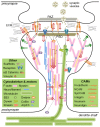The Emerging Role of Mechanics in Synapse Formation and Plasticity
- PMID: 30574071
- PMCID: PMC6291423
- DOI: 10.3389/fncel.2018.00483
The Emerging Role of Mechanics in Synapse Formation and Plasticity
Abstract
The regulation of synaptic strength forms the basis of learning and memory, and is a key factor in understanding neuropathological processes that lead to cognitive decline and dementia. While the mechanical aspects of neuronal development, particularly during axon growth and guidance, have been extensively studied, relatively little is known about the mechanical aspects of synapse formation and plasticity. It is established that a filamentous actin network with complex spatiotemporal behavior controls the dendritic spine shape and size, which is thought to be crucial for activity-dependent synapse plasticity. Accordingly, a number of actin binding proteins have been identified as regulators of synapse plasticity. On the other hand, a number of cell adhesion molecules (CAMs) are found in synapses, some of which form transsynaptic bonds to align the presynaptic active zone (PAZ) with the postsynaptic density (PSD). Considering that these CAMs are key components of cellular mechanotransduction, two critical questions emerge: (i) are synapses mechanically regulated? and (ii) does disrupting the transsynaptic force balance lead to (or exacerbate) synaptic failure? In this mini review article, I will highlight the mechanical aspects of synaptic structures-focusing mainly on cytoskeletal dynamics and CAMs-and discuss potential mechanoregulation of synapses and its relevance to neurodegenerative diseases.
Keywords: cell adhesion molecules; cytoskeleton; dendritic spine; mechanotransduction; motor proteins; synaptic scaffold proteins.
Figures

Similar articles
-
Cell adhesion and homeostatic synaptic plasticity.Neuropharmacology. 2014 Mar;78:23-30. doi: 10.1016/j.neuropharm.2013.03.015. Epub 2013 Mar 28. Neuropharmacology. 2014. PMID: 23542441 Review.
-
Regulation of Presynaptic Release Machinery by Cell Adhesion Molecules.Adv Neurobiol. 2023;33:333-356. doi: 10.1007/978-3-031-34229-5_13. Adv Neurobiol. 2023. PMID: 37615873
-
Cell adhesion molecules at the synapse.Front Biosci. 2006 Sep 1;11:2400-19. doi: 10.2741/1978. Front Biosci. 2006. PMID: 16720322 Review.
-
Identification of Protein Tyrosine Phosphatase Receptor Type O (PTPRO) as a Synaptic Adhesion Molecule that Promotes Synapse Formation.J Neurosci. 2017 Oct 11;37(41):9828-9843. doi: 10.1523/JNEUROSCI.0729-17.2017. Epub 2017 Sep 4. J Neurosci. 2017. PMID: 28871037 Free PMC article.
-
Molecular mechanisms that underlie structural and functional changes at the postsynaptic membrane during synaptic plasticity.Prog Neurobiol. 1998 Aug;55(6):611-40. doi: 10.1016/s0301-0082(98)00026-4. Prog Neurobiol. 1998. PMID: 9670221 Review.
Cited by
-
The truth about 17-beta estradiol: menopause beyond "old wives' tales".Front Endocrinol (Lausanne). 2023 Sep 11;14:1229804. doi: 10.3389/fendo.2023.1229804. eCollection 2023. Front Endocrinol (Lausanne). 2023. PMID: 37766693 Free PMC article. No abstract available.
-
The mechanobiology of biomolecular condensates.Biophys Rev (Melville). 2025 Mar 25;6(1):011310. doi: 10.1063/5.0236610. eCollection 2025 Mar. Biophys Rev (Melville). 2025. PMID: 40160200 Free PMC article. Review.
-
Identification of secretory autophagy as a mechanism modulating activity-induced synaptic remodeling.Proc Natl Acad Sci U S A. 2024 Apr 16;121(16):e2315958121. doi: 10.1073/pnas.2315958121. Epub 2024 Apr 8. Proc Natl Acad Sci U S A. 2024. PMID: 38588427 Free PMC article.
-
Multi-omic profiling reveals the ataxia protein sacsin is required for integrin trafficking and synaptic organization.Cell Rep. 2022 Nov 1;41(5):111580. doi: 10.1016/j.celrep.2022.111580. Cell Rep. 2022. PMID: 36323248 Free PMC article.
-
The MeshCODE to scale-visualising synaptic binary information.Front Cell Neurosci. 2022 Nov 18;16:1014629. doi: 10.3389/fncel.2022.1014629. eCollection 2022. Front Cell Neurosci. 2022. PMID: 36467609 Free PMC article.
References
Publication types
LinkOut - more resources
Full Text Sources

